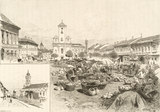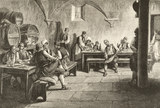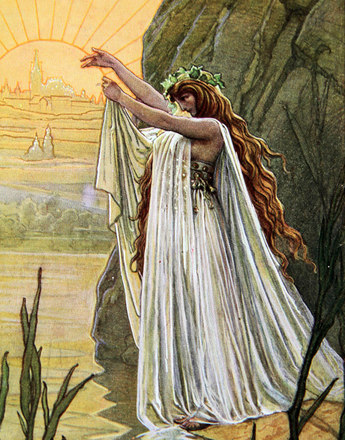-

Karl Cserna:: The main square and Serbian church in Novi Sad, illustration, 1891
Copyright: Schloß Schönbrunn Kultur-und Betriebsges.m.b.H./Fotograf: Alexander E. Koller
-

B. Bukovac: A gusle player playing heroic songs, illustration, 1892
Copyright: Schloß Schönbrunn Kultur-und Betriebsges.m.b.H./Fotograf: Alexander E. Koller
The cradle of modern Serbia was to be found significantly in Vienna and Pest, where small but prosperous and politically influential Serb communities lived in the Diaspora and Serbian intelligentsia absorbed influences from western Europe.
The Serbian language reformer Vuk Stefanović Karadžić (1787–1864) published the first modern Serbian grammar (Pismenica srpskoga jezika, 1814) and his collections of Serbian folksongs and poems in Vienna. They were well received in western Europe, where the emancipation of the Serbs from the Turks was regarded sympathetically. There was also the Romantic image of the Serbs as a combative people of herdsmen and warriors.
Another signpost on the road to Serbian cultural nationhood was the foundation in 1826 of Matica Srpska, a Serbian cultural organization and publishing company in Pest, Hungary (moved in 1864 to Novi Sad).
Karadžić played a significant role in the Serbian national renaissance. He renounced the Serbian variant of the old Church Slavonic liturgical language, used until then as the written and official spoken language but understood only by the clergy. He proposed the use of the spoken vernacular. His grammar, followed by a dictionary, earned him the reputation as creator of the modern Serbian literary language. He chose the most widely used Shtokavian dialect. This dialect was also spoken by the Croats in Slavonia, Bosnia and the Dalmatian hinterland. According to his motto ‘Srbi svi i svuda’ (Serbs all and everywhere), Karadžić’s language reform saw these dialect speakers incorporated in a ‘greater Serbian cultural space’. In this way, the Serbian claim to leadership in the western Balkans was given a linguistic underpinning.
The smaller ethnic groups in the region, such as the Muslim Bosnians, but also the Croats, were sceptical of the Serbian attempts at unification. The Croats, for example, were also interested in a ‘greater Croatia’ in the Illyrian sense with a leading role being played by themselves.
The cultural claims to leadership by the Serbs were soon incorporated in the political programmes. The polemic pamphlet Načertanije (Draft, 1844) by the future Serbian Minister of the Interior Ilija Garašanin (1821–75) was the first official formulation of the greater Serbia programme, which stated that it was the historical task of Serbs to unite the Slavic Balkan peoples. Garašanin also mentioned for the first time the power ambitions of the Habsburg Monarchy in the Balkans as the greatest threat to greater Serbian interests. In Vienna this development was underestimated for a long time because it was assumed that the Serbs in the Military Frontier and the Voivodeship were pro-Austrian.
At first the loyalty of the Hungarian Serbs to the Habsburg dynasty during the 1848 revolution, when the majority of Serbs placed themselves under the protection of Vienna as a reaction to the Hungarian refusal to recognize the rights of non-Magyars, appeared to have been worthwhile. The Serbs achieved autonomy from Hungary for the Voivodeship and the creation of an independent crown land called Voivodeship of Serbia and Banat of Temeschwar.
But the success was short-lived. In 1860 the Voivodeship was once again incorporated in the Kingdom of Hungary. The dismantling of the Military Frontier in 1881 also meant that from then on the majority of Serbian settlements were now under Hungarian or Croatian control, with the Serbs being granted only the status of an ethnic and confessional minority.
The disappointment at the attitude of Vienna was exacerbated by the policy of Emperor Franz Joseph towards the young Balkan state of Serbia in the light of the Russian-Austrian rivalry in the Balkans. While Russia uncompromisingly supported the freedom struggle of the Balkan Slav peoples, Vienna sought to maintain the status quo so that the Ottoman Empire would form a buffer to Russia’s expansionist aspirations.
All this meant that the Serbs in the Habsburg Monarchy turned politically more and more towards Serbia, which had developed in the course of the nineteenth century into an appreciable regional power. Whereas the Hungarian Serbs, who had still been seen as the main supporters of a Serbian cultural renaissance in the first half of the nineteenth century, were regarded around 1900 in the context of Serbian irredentism as ‘unredeemed brothers’ under the ‘Magyar yoke’. Belgrade had become the centre of the Serb nation.
Translation: Nick Somers
Djordjević, Dimitri: Die Serben, in: Wandruszka, Adam/Urbanitsch, Peter (Hrsg.): Die Habsburgermonarchie 1848–1918, Band III: Die Völker des Reiches, Wien 1980, Teilband 1, 734–774
Hösch, Edgar: Geschichte der Balkanländer. Von der Frühzeit bis zur Gegenwart, München 1999
Rumpler, Helmut: Eine Chance für Mitteleuropa. Bürgerliche Emanzipation und Staatsverfall in der Habsburgermonarchie [Österreichische Geschichte 1804–1914, hrsg. von Herwig Wolfram], Wien 2005
-
Chapters
- The Croats in the Habsburg Monarchy
- ‘Loyal rebels: the role of the Croats in the 1848 revolution
- The question of autonomy: the Croats caught between Vienna and Budapest
- The Serbs in the Habsburg Monarchy
- ‘Serbs all and everywhere’: the Serb national programme
- The Bosnians in the Habsburg Monarchy
- Sharia under the Double Eagle: Austria-Hungary and the Bosnian Muslims
- From Illyrism to Yugoslavism: competing concepts for a southern Slav nation
- Friend or foe? The positions of the southern Slavs in the First World War



